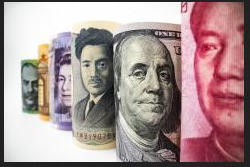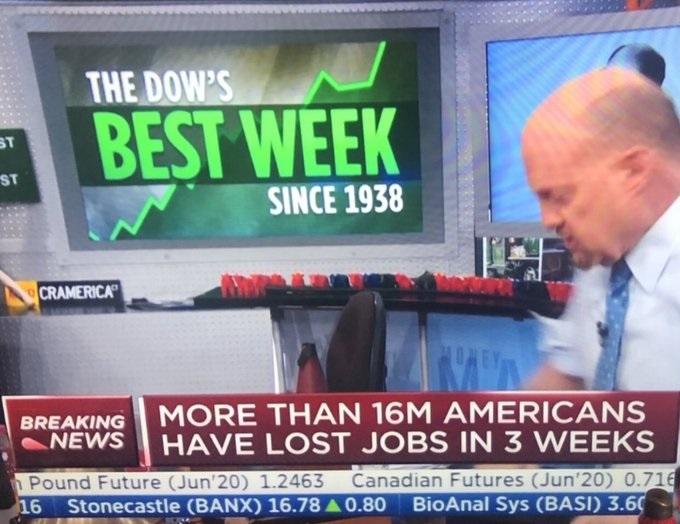All over the world, governments and central banks are addressing the pandemic crisis with three main sets of measures: Massive liquidity injections and rate cuts to support markets and credit. Unprecedented fiscal programs aimed at providing loans and grants for the real economy. Large public spending programs, fundamentally in current spending and relief measures. However, they may cause deeper problems than those they aim to solve. When governments try to artificially boost debt and demand in a supply shock, the risk is the creation a massive deflationary spiral driven by debt saturation that is followed by stagflation when supply chains start to become insufficiently flexible. This is a health crisis and a supply shock added to the forced shutdown of the
Topics:
Daniel Lacalle considers the following as important: 6b) Mises.org, Featured, newsletter
This could be interesting, too:
Nachrichten Ticker - www.finanzen.ch writes Die Performance der Kryptowährungen in KW 9: Das hat sich bei Bitcoin, Ether & Co. getan
Nachrichten Ticker - www.finanzen.ch writes Wer verbirgt sich hinter der Ethereum-Technologie?
Martin Hartmann writes Eine Analyse nach den Lehren von Milton Friedman
Marc Chandler writes March 2025 Monthly

All over the world, governments and central banks are addressing the pandemic crisis with three main sets of measures:
- Massive liquidity injections and rate cuts to support markets and credit.
- Unprecedented fiscal programs aimed at providing loans and grants for the real economy.
- Large public spending programs, fundamentally in current spending and relief measures.
However, they may cause deeper problems than those they aim to solve.
When governments try to artificially boost debt and demand in a supply shock, the risk is the creation a massive deflationary spiral driven by debt saturation that is followed by stagflation when supply chains start to become insufficiently flexible.
This is a health crisis and a supply shock added to the forced shutdown of the economy. As such, policies aimed at boosting demand have very little effect, because whatever demand is artificially created will not be followed by supply as long as the economy remains shut down. Considering that the opening of the economy will be gradual and subject to changes, it may be safe to say that the risk of achieving very little positive impact with these stimulus packages is very high.
Governments make two important mistakes in a lockdown as severe as this one: thinking that the impact is similar in all sectors and believing that a nationwide shutdown will be recovered from swiftly.
There are sectors that will take years to recover: travel and leisure, autos, retail, fashion, music, cinema, tourism and energy all face years of weak demand, balance sheet reparation, and survival-mode strategies.
The collapse in earnings and cash flow, followed by the very probable tax hikes that we will likely see, are also going to create an enormous burden on research and development, innovation, and technology.
The financial sector was already weak in 2019, suffering with negative rates, high nonperforming loans, and weak returns on tangible assets. The impact of the crisis will be severe on existing assets, with rising nonperforming loans and downgrades of earnings. If we add to this that most governments’ stimulus packages are based on approving massive loans for companies that face years of difficulties, the strain on banks is going to be very significant and may lead to a financial crisis after a supply shock.
The key measures that need to be taken in a supply shock with a forced lockdown are supply-side measures: eliminating taxes throughout the lockdown to preserve the business fabric and reducing unnecessary expenditure to accommodate higher healthcare costs.
Some governments, such as the United States administration, are combining both demand- and supply-side measures. Others—most of the large eurozone economies except maybe Germany—are only focused on policies driven to provide credit relief and increased spending.
With these measures in mind, and considering the slump in economic activity, corporate profits, wages, and tax revenues that will be generated, global debt is likely to soar above 350 percent of GDP. This means that the vast majority of the stimulus packages will be aimed at financing higher debt created by government noneconomic-return current spending and hibernating large companies, while small and medium enterprises, which have little access to debt and maybe no assets to leverage, simply disappear. Startups and small businesses may face a double negative of zero access to equity and a collapse in sales.
When governments and central banks announce massive stimulus packages at the very beginning of a crisis, they bet on a speedy recovery and a return to normal as if nothing had happened. This is far from the case. Debt-fueled stimulus may cause a lengthy and painful recovery, generating a deflationary spiral short-term that will likely be addressed with more monetary and fiscal stimulus and then producing stagflation.
The evidence shows that the global economy has recovered in a much slower and indebted way from each of the past crises. However, none of the crises of the past fifty years have been remotely similar to this one. We have never witnessed a global shutdown of the entire economy, and policymakers have no idea about the mid- and long-term ramifications, so doubling down on debt and liquidity is, at least, dangerous.
How do we go from crisis to deflation and then to stagflation?
The process would be the following:
- The crisis is created by the pandemic and the subsequent closing of entire economies in a domino effect, causing strains on supply chains as well as a domino of credit events in highly indebted sectors.
- Governments bail out the large and strategic sectors, as well as citizens, with massive loans, grants, and fiscal measures but leave behind the preservation of supply chains at a global level. As the crisis deepens and lasts longer, governments decide to take protectionist and interventionist measures that further erode supply chains. This period is deflationary because money velocity collapses, investment stops, consumption weakens, and citizens try to hold on to the little savings they have.
- The deflationary and indebted spiral is addressed with more liquidity and more debt, but by now the supply chains have been irreparably damaged and interventionist measures add to rising inflation in the prices of essential goods and services. The economy remains in stagnation but prices creep up.
I genuinely hope that this will not happen. I would be delighted to be wrong.
The pandemic lockdown is showing us the importance of having open supply chains; diversified, global, and efficient companies; and competitive services. It also shows the importance of collaboration.
The solution to this crisis must be global and local at the same time: a global answer that ensures that cooperation and trade are preserved. The local answer must be aimed at ensuring a rapid recovery of the lost jobs by preserving the business fabric and ensuring that companies have the equipment and protocols to come out stronger.
Interventionism will only lead to stagflation.
Originally published at Dlacalle.com
Tags: Featured,newsletter








